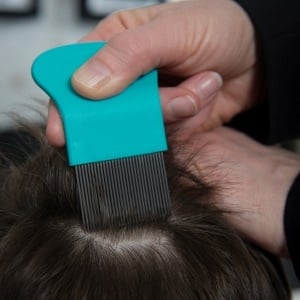You may be surprised to discover that it's actually the faeces
or saliva of the larvae and adult lice that can cause itching, as the host
develops an allergic reaction. Scratching can also irritate the skin, causing
more itching.
Lice and their nits (eggs) are small and, at least initially,
aren’t very noticeable. The first sign of head lice is usually itching,
but a person may have lice for months before actual itching begins, and not
everyone experiences itching. Itching can also be caused by other things like
dry skin or dandruff.
If lice are the culprit, itching is usually worst behind the
ears and at the back of the neck. Swollen lymph nodes in the neck can be an
indication of a more serious allergic reaction. Other tell-tale signs are scalp
redness; red bumps on the neck, scalp and shoulders; and black louse poop that
looks like tiny black specks of "dandruff".
Contrary to what you might have heard, having lice is not an
indication of your levels of hygiene – in fact, according to the British Association of Dermatologists lice
can affect anyone, with long or short hair, no matter how clean the hair is.
Lice can't jump
Lice cannot jump from one person to another and require physical
contact either between humans, or contact with objects like toys or furniture
where lice have been deposited. Adult lice can only live for about 48 hours
without feeding, though, so the risk of infestation from inanimate objects is
smaller.
Because of close physical proximity and shared activities,
schools are hotbeds of lice infestation. Since the banning of the pesticide DDT
in 1973 there has been a steady increase in the number of cases in the USA.(In
1943 the United States Army provided its soldiers around the world with DDT
dust to kill pubic lice, head lice and body lice, primarily to reduce the risk
of contracting typhus.)
Some general infections associated with excessive scratching and/or
infected wounds or bites, according to Lice
Ladies are:
·
Yeast infections: caused by scratching
·
Cellulitis: a
subcutaneous skin infection caused by bacteria that enter the body through
broken skin
·
MRSA (methicillin-resistant Staphylococcus
aureus): a skin infection caused by Staphylococcus bacteria that have become
resistant to certain antibiotics
·
Staph infections: caused by staphylococcus bacteria that
invade the body through the lesions, including infections include boils and
impetigo (a contagious rash).
Getting rid of lice
There are literally thousands of home remedies to get rid of
lice, but basically the process boils down to three essential steps:
1. Kill
the critters! Your
best bet is probably a medicated shampoo from your nearest pharmacy, but there
are many home remedies that reportedly work well. Do take note that lice have
built up immunity against certain chemicals.
2. Get rid
of the nits (louse
eggs) that are attached to individual hairs. For this you need to carefully
comb the hair strand by strand with a fine comb. Every single nit needs to be
removed.
3. Prevent
re-infestation by
washing towels, clothes, bedclothes and even fluffy toys in very hot water.
Also check for lice and nits on a regular basis in case of re-emergence or re-infestation.



No comments:
Post a Comment